MAP / Fairey Capstan
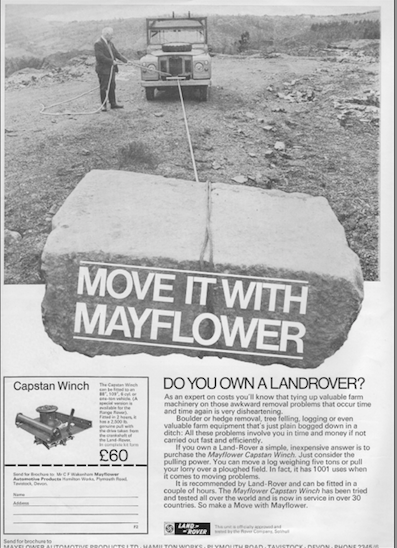
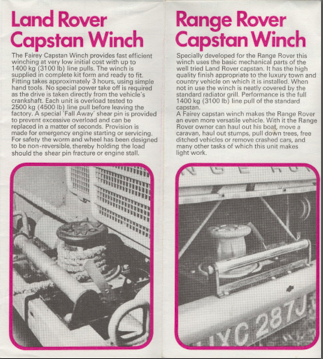
In 1969, Mayflower Automotive Products (MAP) of Tavistock, Devon introduced a new Capstan Winch to compliment their existing range of Land Rover approved optional equipment. MAP had already achieved success with the Mayflower mk3 mechanical drum winch and Free Wheeling Hubs, which were approved a few years earlier. Since 1950, the only approved capstan winch was the Aeroparts winch. The new capstan winch design was undergoing type approval in April 1969 by the Special Projects Dept and was displayed to the public at the ‘Rovershow’ near Northampton.
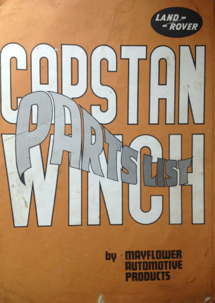
The major
design difference between the Aeroparts and MAP winch was the driveshaft mechanism
and the worm gear layout. The winch input shaft that carried the worm gear was
not an integral part of the gear and could slide within it. Drive was
transmitted from the input shaft to the worm gear via a key-way. This design
allowed for a much simpler driveshaft to be used, made of fewer and less
complicated parts, compared to the Aeroparts design. Importantly, it was the first
capstan winch to fit both the 4 cylinder and 6 cylinder engine without the need
for any modification or additional components.
Other differences included the method of lubrication of the bollard
shaft bushes, using splash lubrication rather than grease as in the Aeroparts type
and the addition of a shear pin within the drive shaft mechanism to allow the
winch to fail safe, if the 2500lb line pull was exceeded, an idea that was
copied by Aeroparts a few years later.
To engage
the winch, the lever at the side of the bollard was moved into the forward
position. This moved the driveshaft towards the engine. The shaft, supported by
a bracket and large conical spring, engaged into a simple drive dog, which replaced
the starter dog on the engine crankshaft. To aid lining up the driveshaft and
the dog, a short starting handle was supplied. This was inserted into the
winches own starter dog.
A very early advert for the ‘new’ MAP Capstan Winch shows an Aeroparts gear casing with a modified fairlead and selector mechanism. It is quite possible this winch was a prototype or ‘mule’ for the production version, using many Aeroparts winch components.
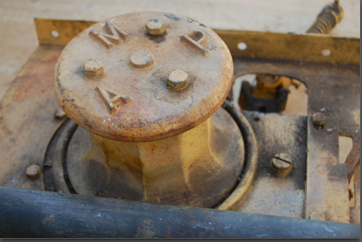
A very early MAP capstan winch with early shaped bollard
The first
few hundred MAP capstan winches had a bollard design similar to the Aeroparts,
but with a flat cap with the head of the securing bolts raised and M.A.P cast
into the top. Somewhere between winch serial number 200 & 400, the bollard
was redesigned to the more recognizable ribbed type with the head of the
securing bolts sunk into the bollard cap. MAP was still cast into the top of
the bollard but the letters were now bold. This bollard design was used up to
the end of production in the 1980’s.
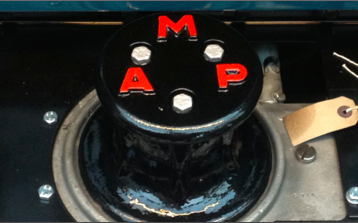
In 1971, Fairey bought MAP and continued to manufacture many of the MAP designs. The capstan winch underwent a number of modifications including replacing the lettering on top of the bollard to FWL (Fairey Winches Ltd) and a modified input shaft to accept the new driveshaft UJ with new screw-in shear pin. The new UJ was shorter than the old MAP knuckle type and the driveshaft was extended accordingly. The diameter of the fairlead roller was reduced and was now made from a solid bar rather than a hollow tube found on the earlier MAP winch. The base plate gained 3 threaded holes to store the spare shear pins and one of the front base plate mounting bolts was replaced with a counter-sunk set screw to stop the rope snagging on the bolt head as it passed through the fair lead. These modifications increased the line pull to 3,100lb, 100lb greater than the rival Aeroparts winch.
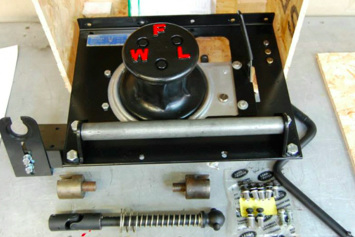
3000lb Fairey winch
In 1978, the line pull of the Fairey capstan winch was increased from 3100lb to 4000lb. This was achieved by the addition of a bronze bush in the winch sump plate and a longer bollard shaft. A new larger diameter shear pin was also introduced at this point. On the standard Land Rover winch, the baseplate was strengthened with the addition of a number of gussets welded to the fold at the back of the plate.
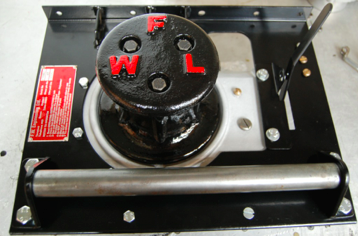
Fairey Capstan Winch for Range Rover Classic
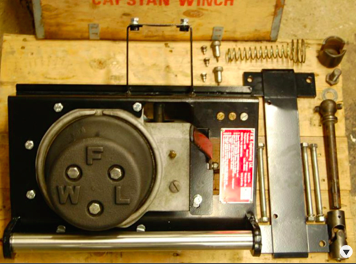
When the
Range Rover was released in 1971, Fairey were quick to capitalize and
adapted their capstan winch to suit. A new baseplate, driveshaft support
bracket and drive dog to fit the V8 engine was introduced, however the
actual winch unit remained virtually unchanged. To retain the
upmarket image of the Range Rover, Fairey marketed the capstan winch with a
chrome fairlead roller, rather than a galvanized one supplied with the Land
Rover version. The winch could be neatly hidden behind the front grill when not
in use. Quick release fasteners were supplied with the kit to allow for the
easy removal of the grill. This winch was fitted to the famous Darien Gap
Expedition Range Rovers.
Fairey Capstan Winch for Stage 1 V8 & 90/110
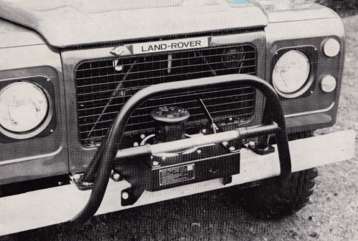
The next new
Land Rover came in the form of the Land Rover Series 3 Stage 1. Once again,
Fairey were quick to adapt their winch to suit. Another new base plate was
designed and an ingenious bull-bar come mounting bracket was developed. It was
another neat solution.
The Stage
1 V8 design was carried forward and once again adapted for use with the Land
Rover 90 / 110 4 cylinders and V8 models.
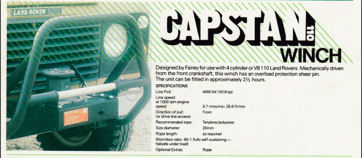
The final
chapter of the Mayflower Capstan Winch story begins with American winch
giant, Superwinch buying FWL in 1985. Superwinch carried on producing the
capstan winch for a short period before finally discontinuing the winch from
their range. The ‘Superwinch’ capstans usually do not have any lettering on the
bollard.
Fairey
‘specials’
Just like
Aeroparts, Fairey identified a market for organizations that used winches for a
very specific task. One organization Fairey focused on was the Coast Guard. And
designed a bollard with a smooth round surface to aid control of the rope while
performing cliff rescue. These winches are very easily identified as they have
‘Fairey Winch CG’ cast into the top. The fairlead is also a different design to
the standard winch and can be unlocked and lifted up to allow the rope to be
placed around the bollard, rather than having to thread the rope through
the fairlead, before wrapping it around the bollard.
Manufactured
for around 20 years and by 3 companies the Mayflower designed capstan winch has
stood the test of time well and is still a popular and sought after accessory
today.
Never miss an offer. Ever.

